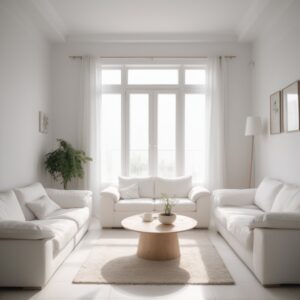Balance is a fundamental principle in interior design, crucial for creating spaces that feel harmonious and visually appealing. It involves the careful arrangement of elements to ensure that no single part of a room overpowers another, fostering a sense of equilibrium and tranquility. Let’s delve into the different types of balance and how to achieve them in your home.
Understanding Balance in Interior Design
Balance in interior design refers to the distribution of visual weight within a space. This weight can be influenced by factors such as color, texture, size, shape, and placement of objects. There are three main types of balance: symmetrical, asymmetrical, and radial. Each type brings its own unique charm and can be used to create various effects in your interior spaces.
Symmetrical Balance
Symmetrical balance, also known as formal balance, is achieved when elements on either side of a central axis are identical or very similar. This type of balance is often seen in traditional and classical interiors, where a sense of order and formality is desired.

How to Achieve Symmetrical Balance
- Mirror Effect: Arrange furniture and décor items in pairs to create a mirror image on either side of a central focal point, such as a fireplace or a piece of artwork.
- Consistent Shapes and Sizes: Use furnishings that are similar in size and shape. For example, place identical sofas facing each other or match two armchairs on either side of a coffee table.
- Equal Distribution: Ensure that elements like lighting, accessories, and colors are evenly distributed across the room.
Asymmetrical Balance
Asymmetrical balance, or informal balance, involves arranging elements of varying sizes, shapes, and colors in a way that creates a sense of balance without exact duplication. This approach is more dynamic and less rigid, making it ideal for contemporary and eclectic spaces.

How to Achieve Asymmetrical Balance
- Visual Weight: Balance different elements based on their visual weight rather than their size. For example, a large sofa can be balanced by a pair of smaller armchairs.
- Groupings: Use groupings of objects to achieve balance. A large piece of artwork on one side of the room can be balanced with a group of smaller pictures on the opposite side.
- Color and Texture: Incorporate contrasting colors and textures to distribute visual interest throughout the space.
Radial Balance
Radial balance occurs when elements are arranged around a central point, radiating outwards. This type of balance is less common but can be highly effective in certain settings, such as dining rooms or entryways.

How to Achieve Radial Balance
- Central Focal Point: Use a central focal point, such as a round dining table or a chandelier, and arrange furniture and décor items around it.
- Circular Patterns: Incorporate circular patterns and shapes to enhance the radial effect. For example, a round rug can help anchor the space and reinforce the balance.
- Even Spacing: Ensure that all elements are evenly spaced around the central point to maintain harmony.
Balancing Color and Texture
Color and texture play a significant role in achieving balance. Here are some tips to keep in mind:
- Color Distribution: Distribute colors evenly throughout the room. Avoid clustering too many bold colors in one area.
- Texture Contrast: Mix textures to create visual interest and balance. Pair smooth surfaces with rough textures, such as a sleek leather sofa with a chunky knit throw.
- Accent Colors: Use accent colors sparingly to draw attention to specific areas and create focal points without overwhelming the space.



The Role of Scale and Proportion
Scale and proportion are crucial for achieving balance. Ensure that the size of your furniture and décor items is appropriate for the room. Oversized furniture in a small space can disrupt balance, while tiny pieces in a large room can feel lost and ineffective.
How to Balance Scale and Proportion
- Proportional Furniture: Choose furniture that fits the scale of the room. Large rooms can accommodate substantial pieces, while smaller spaces benefit from more compact furniture.
- Layering: Layer different sizes and shapes to create depth and interest. For example, layer a large rug with smaller accent rugs or combine tall and short furniture pieces.
Balance is the key to creating interiors that are both visually appealing and comfortable. Whether you prefer the orderliness of symmetrical balance, the dynamic nature of asymmetrical balance, or the unique appeal of radial balance, understanding and applying these principles will help you design spaces that feel cohesive and harmonious. Remember to consider color, texture, scale, and proportion as you arrange your space, and you’ll achieve a beautifully balanced interior that reflects your style and meets your needs.

Leave a Reply